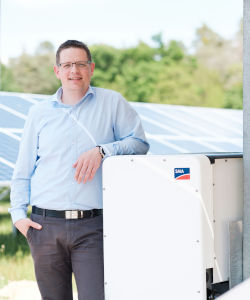Inverters for high-current modules:
the great IDC max misconception

The PV industry is using high-current modules to combat rising system costs. This type of module consists of M10 or larger PV cells, which can accommodate correspondingly high MPP currents (>12 A). Read on to find out what needs to be taken into account in the choice of inverter and what kind of misconceptions can commonly be encountered, as well as the difference between short-circuit current and maximum input current.
When it comes to choosing an inverter, the I SC PV short-circuit current (“SC” stands for “short circuit”) is always the deciding factor. This value indicates the highest electrical current that a PV cell or PV module can deliver. The short-circuit current is specified on the datasheet, in the manual and on the type label for every PV input on an inverter and adhering to it is mandatory for ensuring electrical safety and complying with the warranty.
Difference between short-circuit current and maximum direct current
The value for short-circuit current determined for a PV array must fall below the limiting value for the inverter, with due consideration given to the PV modules and additions or deductions resulting from local conditions such as orientation, solar irradiation, temperature, etc.
By contrast, the I DC max value indicates the maximum current that the inverter is capable of receiving from the PV array. This is often erroneously used as the relevant variable for the maximum short-circuit current (see interview with Mathias Strippel below). Should the MPP current of the PV array exceed the maximum input current (I DC max.) of the inverter in a particular system design, there will not be any potential for damage to the inverter. Exceeding the MPP current therefore also has no impact on the inverter’s statutory warranty. All that may occur as a result are minimal yield losses, but these are negligible in most cases.
Definition of I DC max: maximum current that the inverter can receive from the PV array.
To avoid the common misconceptions surrounding the parameters relating to inverters, SMA is now including an additional note in its information regarding maximum direct current on inverter datasheets:
“Max. input current” → “Max. usable input current (I DC max)”
The reliable Sunny Design planning software, available free of charge, allows the potential impact on energy yield to be calculated in a way that is clear and easy to understand.
We have produced some examples of variations in different locations (see table). It is noticeable that exceeding the MPP current does not have any appreciable impact on the total yield of the PV system.
Here’s something that’s good to know: SMA inverters can be oversized by as much as 150%. The connectable PV power of at least 150% of nominal AC power provides additional reserves for system planning in this case.
| Location | Inverter | I DC max (usable) | I MPP module | Annual yield loss due to current limitation |
| Palermo, Italy | Sunny Boy 2.5 | 10 A | 10.4 A | < 0.1 % |
| Palermo, Italy | Sunny Boy 2.5 | 10 A | 10.9 A | 0.21 % |
| Freiburg, Germany | Sunny Boy 2.5 | 10 A | 10.4 A | < 0.1 % |
| Freiburg, Germany | Sunny Boy 2.5 | 10 A | 10.9 A | < 0.1 % |
| Palermo, Italy | Sunny Tripower 6.0 | 12 A | 13.0 A | 0.15% |
| Freiburg, Germany | Sunny Tripower 6.0 | 12 A | 13.0 A | < 0.1 % |
| Freiburg, Germany | Sunny Tripower CORE2 | 26 | 27 | < 0.1% |
| Freiburg, Germany | Sunny Tripower CORE1 | 20 | 21.8 | < 0.1% |
| Freiburg, Germany | Sunny Tripower X | 24 | 27 | < 0.1% |
Table 1: Examples of different locations and corresponding variations. Exceeding the MPP current has only a minimal impact on the total yield of the PV system.
Summary of key points
- SMA inverters can easily be used with high-current modules.
- The absolute limit is the maximum connectable short-circuit current (I SC PV) of the inverter.
- The maximum input current (I DC max) of the inverter is not an absolute limit in the selection of the PV module.
- All SMA inverters can exceed I DC max without any problems.
- The Sunny Design planning takes all the relevant factors into account and indicates the impact on yield.
- SMA inverters have a connectable PV power of at least 150% of the nominal AC power. That keeps something in reserve for system planning.
Are you looking to plan a system with high-current modules? The free Sunny Design planning tool can help, and will recommend the right inverter for you.
the great IDC max misconception


Do we see Isc stated in module datasheet or we consider Isc * 1.25 as per NEC code to see max current from PV source? So, inverter max Isc needs to be limited by the value obtained by multiplying with 1.25?
Hello Priyank,
Please get back to our SMA Service for further support, thank you.
Sunny regards
Christiane